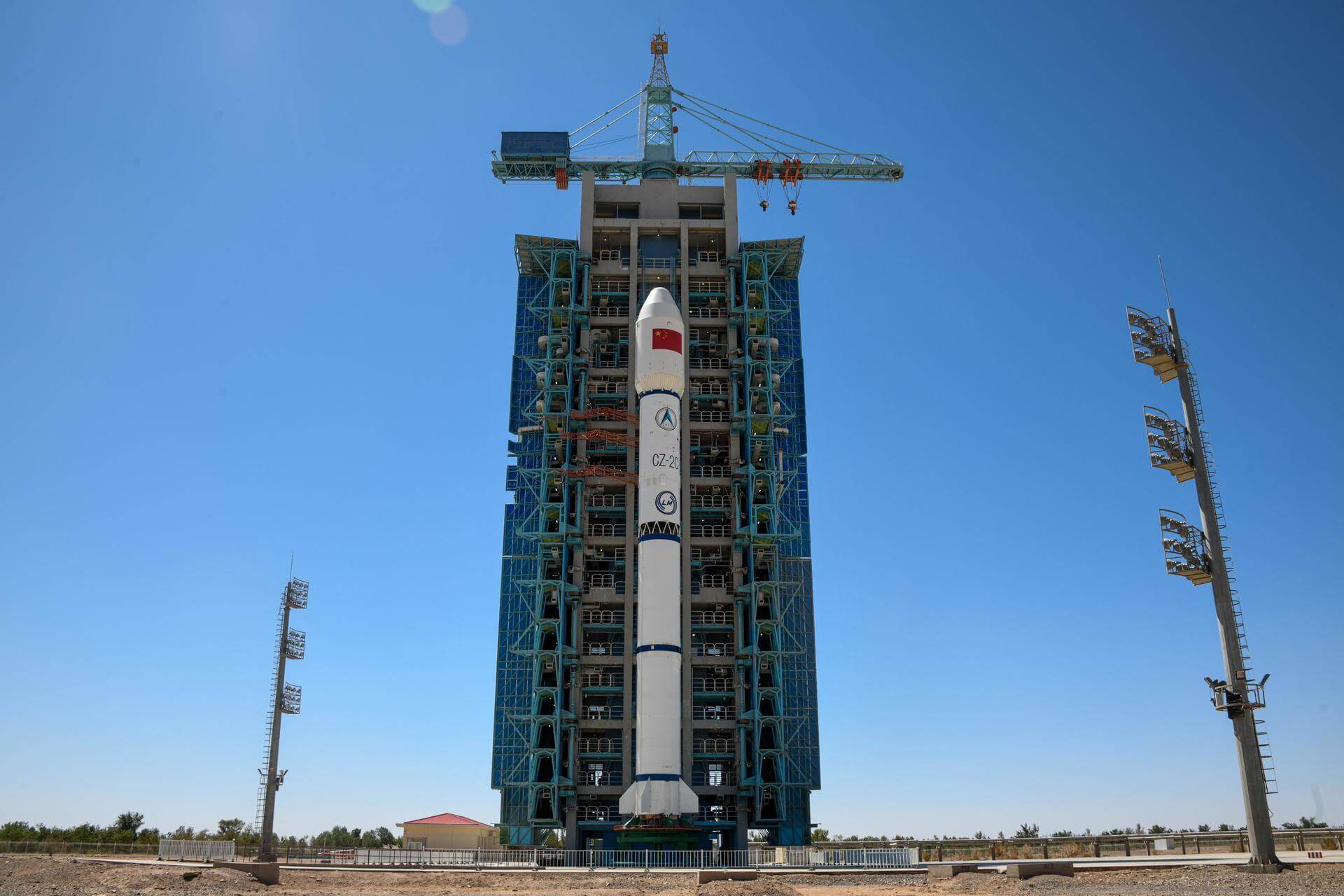· space brief · 6 min read
Space Brief 3 Aug 2025
Today's brief covers NASA's collaboration with India for a new Earth-tracking satellite, China's expansion of its satellite internet network, and a groundbreaking cosmic shield for solar cells. Also highlighted are EchoStar's ambitious satellite order and Roscosmos' recent diplomatic moves.

📄Top Stories
NASA teams up with the Indian Space Research Organization to successfully launch an Earth-mapping satellite, marking a significant milestone in satellite tracking capabilities. Meanwhile, China expands its satellite internet network with another successful launch. In the realm of satellite technology, a new cosmic shield promises to extend the life of solar cells in space.
📰Detailed Coverage
NASA and India Launch Revolutionary Earth-Tracking Satellite
NASA, in partnership with the Indian Space Research Organization (ISRO), has successfully launched the NASA-ISRO Synthetic Aperture Radar (NISAR) satellite. This satellite aims to provide unprecedented mapping of Earth’s surface changes. The launch took place from the Satish Dhawan Space Centre in India on Wednesday, marking a pivotal collaboration between the United States and India in Earth observation technology.
NISAR’s main innovation lies in its dual radar systems operating in the L-band and S-band frequencies, which allow for detailed imaging of Earth’s deformations, glacier movements, and forest biomass changes. This technology will enhance satellite tracking and Earth observation capabilities, aligning with our web app’s feature to provide real-time satellite data and tracking insights.
Read the full story: SpaceDaily
China Advances Satellite Internet Network with Latest Launch
China has broadened its national satellite internet network with the successful deployment of the sixth batch of low Earth orbit (LEO) satellites via a Long March 8A rocket. The launch took place at the Hainan International Commercial Aerospace Launch Center, accentuating China’s robust progress in commercial satellite technology aimed at delivering global internet service.
This series of satellite launches is part of China’s ambition to establish a massive LEO constellation to provide high-speed internet worldwide. The addition of these satellites enhances the global satellite tracking framework, crucial for monitoring space traffic and debris, a significant concern in an ever-crowded orbital landscape.
Read the full story: SpaceDaily
Cosmic Shield Breakthrough Could Extend Life of Space Solar Cells
Engineers at the University of Surrey, in collaboration with Oxford University, have developed a new radiation-resistant coating that could vastly improve the durability of next-gen perovskite solar cells in space. This innovation promises not only to cut costs but also to reduce the weight and enhance the efficiency of satellite solar panels, a significant advancement over traditional models.
The breakthrough focuses on providing enhanced protection against the harsh cosmic radiation environment encountered in space. As satellites rely heavily on solar power, this development could dramatically extend the operational life of satellites, aligning with sustainable and cost-effective strategies for future space missions.
Read the full story: Solar Daily
EchoStar Secures $1.3 Billion Satellite Order Amid Spectrum Scrutiny
EchoStar has commissioned MDA Space for the production of the first 100 satellites in its planned $5 billion low Earth orbit constellation. This move is a significant step toward establishing a direct-to-device connectivity platform, anticipated to revolutionize global communication access.
However, this ambitious project faces challenges, with EchoStar navigating through stringent regulatory scrutiny regarding its spectrum licenses. The outcome of these regulatory hurdles could critically impact the future of the company’s substantial investment in space infrastructure.
Read the full story: SpaceNews
Roscosmos Celebrates Historic Meeting with NASA
Roscosmos has lauded the recent meeting between its leader and the head of NASA as a milestone in international space collaboration. Despite NASA’s minimal acknowledgment of the event, Roscosmos emphasized the significance of renewing bilateral ties, which could pave the way for future cooperative ventures in space exploration.
The meeting highlights the intricate dance of international diplomacy in space, where geopolitical tensions often intersect with scientific and technical collaboration. This development is particularly noteworthy for satellite operators monitoring global space policy shifts.
Read the full story: SpaceNews
🛰️Satellite Spotlight
- Satellite Name: ONEWEB-0651
- NORAD ID: 56080
- Launch Date: March 26, 2023
- Mission: ONEWEB-0651 is part of a satellite constellation aimed at providing global internet broadband services, particularly to underserved areas.
- Orbit: Low Earth Orbit (LEO)
- Operator: OneWeb
- Fun Fact: This satellite is equipped with a Ku-Band payload and is designed to function for over 7 years, contributing to OneWeb’s goal of global connectivity.
Track this satellite in real-time on our web app: Track ONEWEB-0651
🌌Space Weather
Space weather conditions are currently quiet.
Current
R0 - S0 - G0
Last 24 Hour Maximums
R0 - S0 - G0
Recent Alerts
[]
Next 24 Hours
-
Radio Blackouts Probability
- Minor: 35
- Major: 5
- Risk: None
-
Solar Radiation
- Probability: 1
- Risk: None
-
Geomagnetic Storming
- Scale: 0
- Impact: none
- Activity: Low
-
Impact Summary
- Next 24 hours: No risk of radio blackouts or solar radiation storms.
- Geomagnetic outlook: No G1 (Minor) or greater geomagnetic storms are expected.
- No significant transient or recurrent solar wind features are forecast.
- Radiation outlook: No S1 (Minor) or greater solar radiation storms are expected.
- No significant active region activity favorable for radiation storm production is forecast.
- Radio blackout outlook: There is a chance for R1-R2 (Minor-Moderate) radio blackouts over 03-05 Aug.
Long Term Forecast
- Forecast of Solar and Geomagnetic Activity 28 July - 23 August 2025.
- Solar activity is expected to be at mostly low levels with a chance for M-class (R1-R2, Minor to Moderate) flares during the outlook period.
- No proton events are expected at geosynchronous orbit.
- The greater than 2 MeV electron flux at geosynchronous orbit is expected to be at high levels on 28 July, 05-06 August, and 10-23 August due to recurrent coronal hole high-speed stream (CH HSS) influences.
- Low to moderate levels are expected on the remaining days.
- Geomagnetic field activity is expected to be active to G1 (Minor) storm levels on 04 August, 07-14 August, and 18-22 August due to recurrent CH HSS effects.
- Quiet to unsettled levels are expected on the remaining days of the outlook period.
🚀 Upcoming Space Launches
August 3
- Blue Origin New Shepard:
- NS-34 from West Texas Suborbital Launch Site, Corn Ranch (12:30 UTC) NS-34 is the 14th crewed flight for the New Shepard program.
August 4
- SpaceX Falcon 9:
- Starlink Group 10-30 from Cape Canaveral Space Force Station (04:11 UTC) A batch of 28 satellites for the Starlink mega-constellation - SpaceX’s project for space-based Internet communication system.
- China Aerospace Science and Technology Corporation Long March 12:
- SatNet LEO Group TBD from Wenchang Space Launch Site, People’s Republic of China (10:14 UTC) A batch of Low Earth Orbit communication satellites for the Chinese state owned SatNet constellation.
August 5
- Rocket Lab Electron:
- The Harvest Goddess Thrives (iQPS Launch 4) from Rocket Lab Launch Complex 1, Mahia Peninsula, New Zealand (03:45 UTC) Synthetic aperture radar Earth observation satellite for Japanese Earth imaging company iQPS.
August 7
- SpaceX Falcon 9:
- Project Kuiper (KF-02) from Cape Canaveral Space Force Station (14:01 UTC) Second of three launches for Amazon’s Kuiper low Earth orbit satellite internet constellation. 24 satellites are on board.
August 10
- SpaceX Falcon 9:
- Starlink Group 17-4 from Vandenberg Space Force Base (02:05 UTC) A batch of 24 satellites for the Starlink mega-constellation.
- SpaceX Falcon 9:
- Starlink Group 10-20 from Cape Canaveral Space Force Station (12:16 UTC) A batch of 28 satellites for the Starlink mega-constellation - SpaceX’s project for space-based Internet communication system.
August 11
- United Launch Alliance Vulcan VC4S:
- USSF-106 from Cape Canaveral Space Force Station (00:07 UTC) The launch will deploy various payloads directly into geosynchronous orbit, including the NTS-3 (Navigation Technology Satellite 3).
August 13
- SpaceX Falcon 9:
- Starlink Group 10-11 from Cape Canaveral Space Force Station (00:00 UTC) A batch of 28 satellites for the Starlink mega-constellation - SpaceX’s project for space-based Internet communication system.
- SpaceX Falcon 9:
- Starlink Group 17-5 from Vandenberg Space Force Base (00:00 UTC) A batch of 24 satellites for the Starlink mega-constellation.
Note: Launch dates and times are subject to change due to technical or weather considerations.

Maurice Stellarski




